| Mont
Blanc mountain
focus |
 |
|
|
|
|
 |
|
| Introduction
to the aims of the focus page |
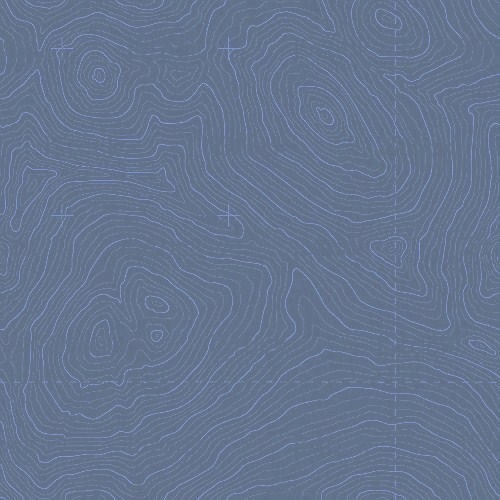 |
 |
| Chamonix-Mont-Blanc
takes its full name from the mountain that towers above
it, so we thought it a good idea to provide you with more
information about the peak which dominates the local region
in so many ways. The page has been produced by our Alpine
logistics team, who between them have been to the summit
over tens of times. To look at the Mont Blanc Summit course
page click
here . |
|
| For
a mountain that has been in existance for many millions
of years, our knowledge is tiny, and anyone who plans
to climb Mont Blanc must remember that. Each year nearly
300 people die in the massif, and if this page can reduce
that number by just one, then it has been a success. Mont
Blanc is the mountain with the highest number of fatalities
in the world, largely due to the numbers of people who
attempt it, so even though the chances of accidents are
still low, the numbers of climbers inflate the total figures. |
|
| There
is hopefully lots of good advice on this page, whether
you are a relative beginner or an expert, but if you are
to take away any lessons from this then here are the key
three points. |
|
1) The mountain will always be there. Don't push safety
boundaries on ascents, as another can be made.
2) The key to success is preparation in terms
of information, equipment, training, techniques &
planning.
3) Never set off considering rescue as an option
(unless there is an accident). Don't play poker with
lives. |
|
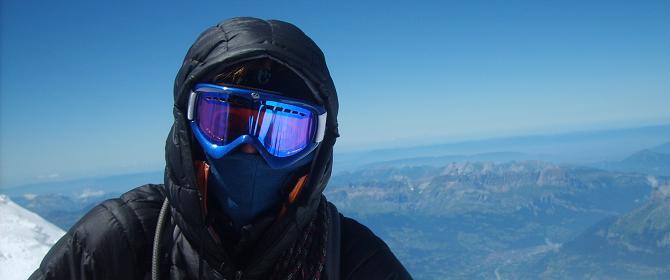 |
|
As
you can see from the photo above, Mont Blanc is a mountain
never to underestimate in any form. True it is nearly
a kilometer lower than the likes of Kilimanjaro, but it
is leagues harder, often colder, and all on snow. If someone
had told you the photo above was taken from a Himalayan
summit, you would not be stupid to have believed them.
The training, equipment and preparation should be similar.
After reading all this information, you may get a different
impression about the Mont Blanc than you started off with.

You must realise that this page is a totally unsanitised
list of facts, with no commercial bias. If the facts put
you off wanting to ascend the mountain, then that may
be a blessing in disguise, as everyone should have free
access to these truths. Our hope however, is that this
information inspires you and makes you wiser, more motivated,
and better prepared to enjoy an experience that will surely
be one of the highlights of your whole life. Please feel
free to e-mail the link to this page to any of your friends
considering an ascent. |
|
 |
 |
| Mont
Blanc & the traverse, from the Aiguille du Midi |
Trois
Mont Blancs traverse, and the Grand Mulets |
|
|
| Popular
route choices on Mont Blanc |
 |
 |
|
|
Near
Tete Rousse |
|
|
View
up to Gouter |
|
On
the summit |
|
|
|
|
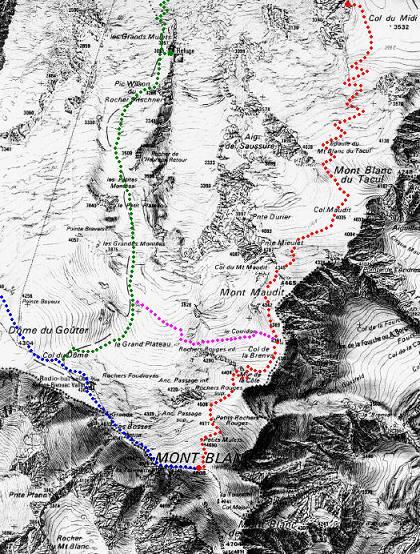 |
|
View
to Aig du Midi |
|
On
the summit |
|
On
the summit |
|
|
At
Breche Maudit |
|
|
|
The
Gouter Route - blue dots on map
This is considered to be the normal
route up Mont Blanc, and ascends in two stages, but it
should
not be under-estimated. On
the first day the climb takes you up to either the Tete
Rousse or Gouter huts. Two hours separate these two huts,
and if you are worried about acclimatising the Tete Rousse
is preferable, though it is a longer day on the summit
climb. From the Aiguille du Gouter, the route ascends
over the Dome du Gouter and then to the Vallot refuge.
Here the route meets with the Grand Mulets route to the
summit. The final ridge is one of the most spectacular
snow ridges in the Alps, and anyone who degrades this
route by describing it as a 'slog', probably hasn't reached
the summit by this amazing summit ridge. |
 |
Trois
Mont Blanc Traverse - red
dots on map
The route starts from the Cosmiques
Hut on the Col du Midi. To reach this you need to take
the Aiguille du Midi cable car from Chamonix. The normal
starting time in the morning is a 2am wake up, aiming
to leave the hut by 2:30am. The route firsly ascends up
to the shoulder of Mont Blanc du Tacul, and then crosses
Col Maudit to ascend the steep slopes to Breche Maudit.
Here you lose about 100m height to reach the Col de la
Brenva. Just ahead is the last steep section of the Mur
de la Cote, which is followed by a flatter area just before
the final slopes up to the summit. The normal ascent time
is about 6 hours from the hut. |
 |
Grand
Mulets Route - green dots on map
The Grand Mulets route starts from
the Plan d'Aiguille cable car station, and ascends over
a very broken glacier to the Grand Mulets hut. From here
the path leads up to the Grand Plateau, before turning
up steeper slopes to the Col du Dome and Vallot emergency
refuge. From here the route ascends the ever narrowing
ridge to the summit, along the top section of the Gouter
route. This route is generally used in Spring on skis
to ascend Mont Blanc, or in descent in early Summer season. |
 |
Corridor
/ Original Route - purple dots on map
This route is that taken by Balmat
and Paccard on their first ascent of Mont Blanc in 1786.
They followed the Grand Mulets route up to the Grand Plateau,
then went along this route to the Col de la Brenva. From
here they went up the top section of the Trois Mont Blanc
route. The Corridor route is rarely used in ascent, though
is a popular choice of descent route on skis / snowboards
in Spring. |
 |
Gonella
Route - this route is
from the south (Italian) side
This route is not shown on the map
above, as it lies to the south side of the mountain. The
approach is made via Lac Combal in the Italian Val Veny,
close to Courmayeur. It is the technically easiest approach
to any hut on Mont Blanc (grade F), and involves a trek
up the stone covered Miages glacier, followed by a short
via feratta to the hut. The next day is long, though technically
easy, via the Col du Dome, and up the final ridge to the
summit, sharing the same route as the upper section of
the Gouter route. The descent is usually made via the
same route, or alternatively you can descend the Gouter
or Trois Mont Blanc routes. This route is generally only
in condition until mid-July. |
 |
|
 |
Explore
Mont Blanc on Google Earth
To help you prepare and
explore Mont Blanc before you travel, we have
developed a Google Earth file with all the key
features and places of interest marked on it.
All you need to do is download the file by clicking
on the link below, or the image to the left. You
can then launch Google Earth, and visit the peaks,
huts, and cable cars on Mont Blanc. Click
here for Google Earth file.
If you do not already have Google Earth installed
on your computer, click
here.
It is a free download, and the satellite images
are constantly uploaded. You can alter the viewing
angles to 'see' Mont in 3D, and to explore the
routes via the Trois Mont Blancs or Gouter. |
|
|
| Focus
on the two most popular routes up Mont Blanc 4810m |
 |
 |
GOUTER
ROUTE
(higher diagram)
1010m Les Houches
1794m Bellvue station
2372m Nid d'Aigle
3167m Tete Rousse hut
3817m Gouter refuge
4304m Dome du Gouter
4255m Col du Dome
4362m Vallot Refuge
4515m Petite Bosse
4810m Mont Blanc |
|
|
 |
Above
the Gouter hut |
|
|
 |
On
the Bosses Arete |
|
|
|
 |
Mont
Blanc summit |
|
|
 |
On
the Col du Midi |
|
TRAVERSE
ROUTE
(lower diagram)
1030m Chamonix
3842m Aiguille du Midi
3613m Cosmiques Hut
3542m Col du Midi
4100m Epaule du Tacul
4035m Col Maudit
4400m Breche Maudit
4303m Col de la Brenva
4640m Mur de la Cote
4810m Mont Blanc |
|
|
|
 |
|
The
Gouter Route
The Gouter route is seen as the
normal route up Mont Blanc, and is technically one of
the easier, so gives relatively inexperienced climbers
the
best chances of summit success.
It is preferable to stay in the higher Gouter hut for
the night before, which takes about five hours to reach
from the Nid d'Aigle (Eagles Nest) mountain railway station.
On the way to the hut you will pass the Tete Rousse hut
and then approach the Gouter Grand Couloir, the greatest
danger on your ascent. The couloir is about 50 metres
wide, and depending on the amount of ice up high, the
temperature, and the time of day, some rocks can fall
down from time to time. To minimise the risk you cross
the couloir when the temperatures are cold such as in
the early morning. Once on the far side of the couloir,
the next consideration is the rocky ridge leading up to
the hut. Although the scrambling is easy, many tired people
lose their footing here, so be careful. The Gouter hut
is one of the busiest in the Alps, so getting spaces there
is difficult. The next morning you should set off early
to get the best conditions on your way to the summit.
After the long climb to the Dome du Gouter, you quickly
reach the Vallot emergency refuge, and after there you
can see the final summit ridge. The first consideration
are the two domes of the Bosses (Bumps), which are quite
broken with crevasses. After the Bosses the ridge narrows
and steepens to the summit. The exposure is high, and
many turn back before the Tournier Rocks, due to a lack
of skill and confidence on ridges. The route is also very
exposed to wind throughout, so there are two considerations;
winds too high to walk safely, and also exposure. The
snow ridge above the Vallot is amazing, and if you are
well acclimatised and good on crampons, you will love
ascending this crest all the way to the summit. |
 |
Trois
Mont Blanc Traverse
This route has increasingly fallen
out of favor due to the avalanche risk on Mont Maudit
after fresh snow, and the stage of the seracs on Mont
Blanc du Tacil. Some sections, such as the seracs on Tacul
and the ascent to Breche Maudit are often very steep.
In years when this is the case the leader might even require
two axes. You should note that if this route is a challenge
for you technically to climb, you will find it harder
to descend by the same route, and most groups opt to descend
by the Gouter route, as height is dropped quickly, and
it is easier. Also the route takes longer than the Gouter,
so requires a higher level of fitness and drive. There
is an advantage of this route over the Gouter, in that
this route involves no climbing on loose rock with the
associated dangers of rockfall. All the climb is on snow
and ice, which necessitates good crampon technique, especially
on the steeper sections and when you start to get tired.
A disadvantage of the route is its length, in that if
bad weather does arrive, you are a long way from shelter.
You should therefore only consider this route is the weather
is stable. Another advantage of this route is that it
is generally ascending the Mont Blanc from the NW, and
as the prevailing winds are from the SW usually, this
means that the route is a lot more sheltered than all
the others considered. |
 |
Grand
Mulets Route
The reason that this route is so
much less popular than the others is due to global warming.
The glacier is becoming increasingly broken up, and the
snow bridges over crevasses often only last until early
July. Also a large section of the route is threatened
by serac falls from the ridges of the Dome du Gouter.
The other issue of the route is the traverse from the
glacier towards the Plan d'Aiguille cable car. This section
is constantly threatened by stonefall, especially on the
section beneath the NW face of the Aiguille du Midi. Here
there are small shelters hewn into the rock to crouch
in until stones stop falling. Really this route is only
a consideration as a means of descent in very early summer,
or on skis in spring. To consider this route your glacier
travel and crevasse rescue skills should be very good. |
 |
Corridor
/ Original Route
As the approach to this route is
from the Grand Mulets route (with all its dangers detailed
above), this route has become correspondingly very little
used, though it is a common route taken by skiers on the
descent of Mont Blanc on its North Face. The only other
considerations for this route are serac falls on the steepest
section, but the dangers are quickly passed. |
 |
Gonella
Route
This route is arguably the easiest
route on Mont Blanc both technically, and in terms of
the lowest objective dangers (e.g. stone fall etc). As
it involves a south facing glacier, the route is generally
only in condition from June to mid-July, but it offers
a good alternative when there is higher risks of rockfall
in the Gouter couloir, or if people have less technical
skills, or have fear of exposure. The only negative of
this route, when it is in good condition, is that it involves
a quite long summit day of c.7-8 hours from the hut. This
is very comparable to ascents from the Tete Rousse hut. |
 |
Summary
The clear message that comes through
on all the points made above is that there is a balance
to be made between physical and technical performance,
weather and conditions, objective and subjective dangers.
Each person will have their own answer to these balances,
and the route should be selected accordingly. Here are
the one liner sumamries: Trois Mont Blanc Traverse:
this is a mountaineers route, with low objective dangers,
though requiring good physical condition, acclimatisation
and crampon technique. The Gouter Route: an easier
technical route, though with high objective dangers (rockfall). Grand Mulets Route: Only really consider this
as a means of descent in summer, and preferably only on
skis in the spring. Corridor / Original Route:
Only really consider this for skis in spring. Gonella
Route: This is a long, but easy route on Mont Blanc,
generally only on condition in the early summer season
each year. |
| |
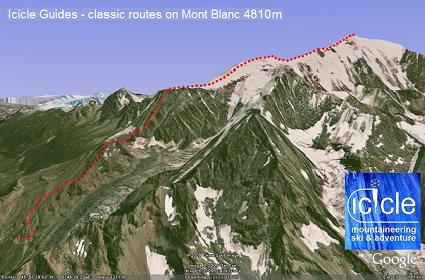 |
Mont
Blanc routes
If you would like
to read some more about the different routes up
Mont Blanc, please visit the dedicated Mont
Blanc mountain focus page.
The graphic to the left shows the classic Gouter
route and Trois Mont Blancs / Traverse route. |
Suitable
for novices?
Mont
Blanc isn't an ideal first Alpine 4000m peak,
but on the other hand it is not technically difficult.
You require excellent fitness and stamina, as
well as great balance combined with the ability
to move quickly and efficiently over broken mountain
terrain. |
|
 |
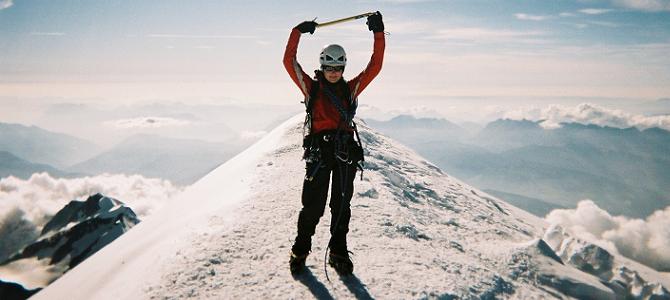 |
 |
| PHOTO:
Rachel celebrating on the summit of Mont Blanc 4810m,
climbed via the Traverse Route. |
|
| The
annual diary for Mont Blanc |
 |
 |
| Due
to the seasonal weather, snowfall, and windspeeds, Mont
Blanc is not climbable for the majority of the year. This
short climbing season is further restricted by the opening
months of the lifts and huts, which are generally necessary
for an ascent of the mountain. The diary below considers
each month individually, so you can plan when is the optimal
time for your ascent. Unfortunately there is no one answer,
as it must always be a balance of the weather, number
of others on the mountain, hut bookings, your fitness,
and time off work. |
|
January:
Generally unclimbable due to the depth of fresh snow
/ avalanches.
February:
Generally unclimbable due to the depth of fresh snow
/ avalanches.
March:
Generally unclimbable due to fresh snow / avalanches,
though ski touring possible.
April:
First ascents on skis may be possible from mid-month,
unless there is lots of snow.
May:
Ski ascents / descents are possible, though no easy
mountaineering routes possible.
June:
Ski ascents / descents, & from early in the month
the mountaineering routes are in condition.
July:
Mountaineering routes in condition, and get busier towards
the middle and end of the month.
August:
Mountaineering routes are in condition, though getting
quieter at the end of the month.
September:
Mountaineering routes are in condition, though it is
colder up high due to Autumn.
October:
Ascents may be possible, but there will be the first
snows, and it will be very cold.
November:
Generally unclimbable due to unsettled weather and snowfall.
December:
Generally unclimbable due to the depth of fresh snow
/ avalanches. |
 |
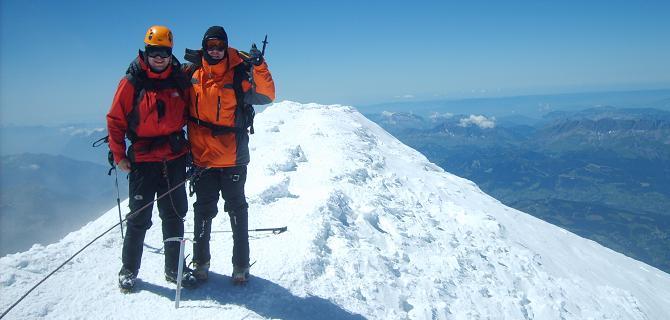 |
 |
| PHOTO:
Chris & Joe on the summit of Mont Blanc 4810m, ascent
via Traverse, descent via Gouter. |
|
| Mont
Blanc mountain huts information |
 |
 |
| The
Mont Blanc massif has many refuges, and on the routes
detailed above, the key huts are profiled below. If you
are planning an ascent of Mont Blanc you must book the
huts a good few weeks in advance to avoid disappointment.
We book many of the hut spaces several months in advance
for our course clients. When staying in huts you don't
need to carry any extra equipment as everything from blankets
to food is provided. There is no need to take sleeping
bags, bivvy bages, stoves, etc. You may notice that the
Vallot refuge has not been featured here. This is because
it should not be used to stay in, except in an emergency
situation. |
|
| Cosmiques |
Gouter |
Tete
Rousse |
Grand
Mulets |
Gonella |
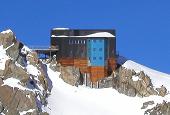
|
 |
 |
 |
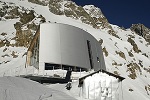 |
This
is situated just above the Col du Midi, and the
hut is one of the best maintained and most modern.
Most of the rooms accommodate twenty people, on
tiered sleeping platforms. The hut is used on
the traverse route up Mont Blanc and the normal
wake up time to start the ascent is 02:00. |
The
New Gouter is the most popular hut on Mont Blanc,
and is always very busy. The refuge is the highest
on Mont Blanc, so gives you the shortest summit
day. It is amazing that you can get a good three
course meal and breakfast at 3900m, but the Gouter
hut staff do a great job. Wake up is 02:00. |
Although
lower than the Gouter, the New Tete Rousse hut
is finished and is a real alternative to the Gouter
hut, as it only makes the climb a couple of hours
longer. The old hut may be used in busy periods
and is quite dirty also. The wake up time is midnight
in order to ascend to Mont Blanc. |
The
Grand Mulets is a very well run hut on the original
route up Mont Blanc. It is situated on a nunatak
(rock island in a glacier), and is normally used
for people descending the mountain, or for those
climbing Mont Blanc on skis in late Spring time.
The hut can't usually be used from early summer. |
The
Gonella Hut is on the Italian side of the mountain,
and is a futuristic shape. The hut is built on
a rock island above the Miages glacier, and the
hut approach is typically 4.5 hours. The set off
time for Mont Blanc is very early from this hut,
as the ascent is easy but quite long. Wake up
c.01:00. |
|
|
| Physical
and technical preparation for an ascent |
 |
 |
| We
have seen guests come, who have never been on crampons
on their life, but who have succeeded on Mont Blanc due
to great personal fitness and a real aptitude on crampons
due to good balance and movement. It is not a surprise
that guests like this only come along every now and then,
perhaps numbering no more than 5 to 10 a season. Equally
at the other end of the scale, some guests have used crampons
for several weeks before, and yet are let down by poor
balance and / or physical condition. So with this situation,
how do we advise people to prepare? The honest answer
is that it is very difficult, and just as important as
the physical and technical preparation, is your psychological
readiness. Several people each year, decide against attempting
Mont Blanc, when they arrive in Chamonix and see the scale
if it, towering the height of three Ben Nevis's above
them. It is naive for inexperienced people to say "I
am so determined, I will get up there and nothing will
stop me", when they don't know what levels of
determination are required as they have never been on
crampons and to altitude before. So here is some advice
from the Icicle guiding team, to help you assess your
preparations... |
 |
 |
"My
view is that mountaineering is an apprenticeship,
and for many people Mont Blanc is not an ideal first
4000m peak. It is better to learn the use of crampons
first and to climb a easier 4000er such as Weismeiss
or Gran Paradiso, then to consolidate your skills
before planning an attempt on Mont Blanc. By then
you will have at least two or three weeks experience,
know what equipment to take, and be physically ready."
Jacques, IFMGA Mountain Guide |
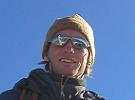 |
"As
well as a good level of fitness, it is very important
for people to have good 'equilibre' as we say in
France, which translates as balance and movement.
On any of the routes on Mont Blanc there are sections
where it is imperitive that you move quickly and
efficiently, both to guarantee your safety, and
to reach the top. Balance is a skill you can improve
at a climbing wall, but there's no substitute for
practicing on steep broken ground."
Gilles, IFMGA Mountain Guide |
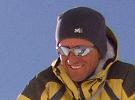 |
"Mont
Blanc is a joy to guide when the conditions are
good, and the clients are prepared, and it quickly
becomes impossible if people are not ready. My opinion
is that clients must take their preparation seriously,
as the mountain is not a consumer product, where
it is the guides job to drag you up. Not at all,
we are there for your safety, to tell you about
the region, and to share the Mont Blanc with you.
It is a special experience."
Jean-Luc, IFMGA Mountain Guide |
|
 |
| As
you can see from the advice above, there is less worry
about your technical ability in terms of knowing knots
and ropework, than there is about your fitness, choice
of equipment, and movement on steep ground. You can be
taught the technical skills in a week, but it is impossible
to train you physically and to give you balance, within
a week. There is no option but to come prepared. Marathon
fit. Great balance. Suitable equipment. Any less, and
it is likely that you have defeated yourself before you
even set foot on the mountain. So yes, it is possible
for people to ascend Mont Blanc who have no previous experience,
but they are coming with everything else, and the weather
and conditions are kind. It is a privelege to take those
last steps to the roof of the Alps, not a guarantee. |
|
|
|
| Summary
and postscript to the focus page |
 |
 |
| This
page is constantly updated as a result of changing techniques,
conditions, and latest news. Please don't use this page
alone as the research you undertake for an ascent, and
it does definately not attempt to offer any of the instruction
of techniques which you will require. Details of many
other sources of information have been provided, which
you should consult before an ascent. Remember that to
climb Mont Blanc is really a privilege, not a guarantee.
If you found this page of use, and have any other information
that others may find helpful, then please e-mail us. We
will post any useful extra information on the page, and
you will be cited. It is this sharing of knowledge that
makes the climbing community so close, and this extra
knowledge will increase your chances of summitting. |
|
 |
|

